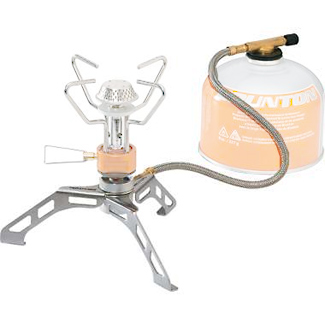nhluhr wrote:Probably because PR agents, marketing writers, and journalists don't have engineering degrees.squishy wrote:CClaude wrote:Actually cannister stoves work better at higher altitude
That statement contradicts everything I've read or been told about canister stoves...
The only thing that causes a problem for canister stoves is cold, since they generally rely on the vapor pressure of the liquid fuel to push gaseous fuel out of the nozzle. If the fuel gets too cold and won't vaporize, it doesn't feed gas to the nozzle. As you may be able to tell, the relative pressure pushing gas out of the cansiter will be the difference in internal pressure (which is a function of temperature and type/amount of gas remaining) and external temperature. If you drop the outside temp by ascending in altitude, the resulting difference in pressure is bigger. The confusion that most journalists and marketeers don't understand is that high altitude generally comes with an associated drop in temperature (which dramatically affects the internal pressure).
n-butane (like in your typical bic lighter or like what's mixed in a Primus fuel canister) boils at 32 deg F (0 deg C). This means if the canister hits below that temp, there is little or no n-butane gas boiling off the liquid in the canister to flow out the fuel line to the nozzle.
iso-butane (like in some high end lighters or what's mixed in Snow Peak ProIso, MSR IsoPro, Jetboil canisters, etc) boils around 12 deg F. This means canisters utilizing isobutane instead of n-butane work at lower temperatures.
Propane (like what's mixed in almost all common canisters to some concentration or what's present in those heavy steel green or white canisters for coleman stoves) boils around -40 deg F. This is what they use in northern michigan when they go ice fishing in the winter.
The colder you get, the lower the partial pressure for the fuels gets and the smaller the partial pressure relative to other components of the fuel, the less of that component gets boiled off and used in your stove. If you use a canister between the boiling points of the fuel components, you will eventually end up with a canister with no more propane to boil off and a bunch of liquid butane.
The Snow Peak ProIso canisters have a mixture of 65% isobutane and 35% propane. Other isobutane/propane mixture canisters are 70/30. This higher propane concentration means they will work longer/harder in colder temps.
Primus canisters are all but useless in cold weather situations becuase they use n-butane as their primary component.
There is a way to defeat the above problems to deal with ultra-cold conditions and that is to use a remote fuel canister with stoves such as the Jetboil Helios, Primus EtaPackLite, or similar stoves that have a pre-heat coil (fuel line goes through the flame) and the ability to invert the fuel canister. This means only liquid fuel is pushed out the nozzle of the canister, leaving gaseous propane (plus whatever amount of butane that boils off in your temperature application) to keep the canister pressurized.
Inverting the canister with something like a Brunton Stove Stand doesn't work well for stoves like the MSR Reactor or Primus EtaExpress because they don't have fuel pre-heat lines to vaporize the fuel before it gets to the regulator/nozzle. The reactor does still work better than some at low temperatures because its regulator seems to run at little lower pressure, so it's usable longer, but in use, the Reactor still loses power in cold unless you take measures to keep the canister warm.
Stoves for Climbing
Post climbing gear-related questions, offer advice. For classifieds, please use that forum.
-
Kai - Posts: 722
- Joined: Thu Jun 23, 2005 2:26 pm
- Thanked: 56 times in 42 posts
by Kai » Fri Apr 16, 2010 7:10 pm
This post really should be pinned in an FAQ somewhere.
-

Honkeydong - Posts: 374
- Joined: Tue Feb 12, 2002 4:48 pm
- Thanked: 0 time in 0 post
by Honkeydong » Sun Apr 18, 2010 8:01 am
MSR Reactor will work out with very few problems, providing you are climbing in a civilized nation where fuel cannisters are plentiful. If not, they'd retail for around $89.00 USD.
Oh yeah- those dissertations on this topic are impressive. Where do ya'll find the time...
Oh yeah- those dissertations on this topic are impressive. Where do ya'll find the time...
-
- Related topics
- Replies
- Views
- Last post
-
- isobutane fuel stoves
by mountainsandsound » Wed Aug 29, 2012 2:34 am - 1 Replies
- 1582 Views
- Last post by radson

Wed Aug 29, 2012 7:04 am
- isobutane fuel stoves
-
- Traveling Internationally with stoves?
by wjblazek » Wed Sep 16, 2015 12:29 am - 5 Replies
- 5479 Views
- Last post by kevin trieu

Thu Sep 17, 2015 12:06 am
- Traveling Internationally with stoves?
-
- Climbing with a camera?
1, 2, 3, 4, 5by Tools_Incoming » Mon Jan 02, 2012 12:34 am - 61 Replies
- 35082 Views
- Last post by pjames

Thu Jan 19, 2012 7:12 am
- Climbing with a camera?
-
- Climbing Harness.
1, 2by CastillejaMiniata » Wed Feb 23, 2011 6:54 am - 22 Replies
- 9804 Views
- Last post by FRhoderick

Fri Mar 04, 2011 10:13 pm
- Climbing Harness.
-
- Climbing Clubs
by alpinedon » Fri Feb 05, 2010 6:59 pm - 10 Replies
- 3336 Views
- Last post by 1000Pks

Sat Feb 06, 2010 6:04 am
- Climbing Clubs
Who is online
Users browsing this forum: No registered users and 0 guests
You need to login in order to vote!
Don't have an account?
- Rating available
- Suggested routes for you
- People who climb the same things as you
- Comments Available
- Create Albums



